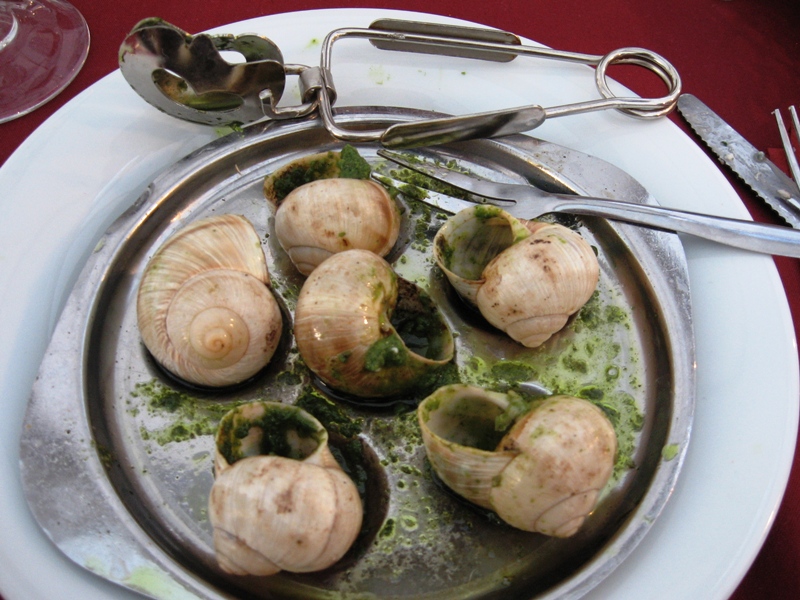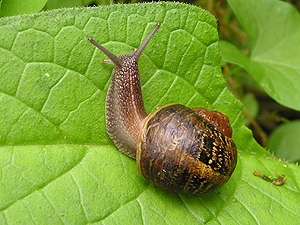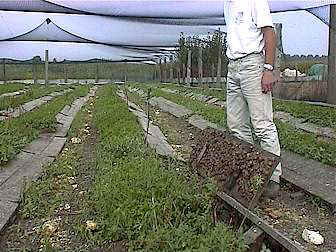The word for the day is "heliciculture", or as the French say, héliciculture, the rearing of that gastronomic delight, l'escargot. Though we don't make the distinction here in the States, the French divide snails into two types: escargot, which are edible, and limaçon which are inedible (a pejorative term based on limace, the French word for that snail relative, the slug).
Snails have been consumed by humans since prehistoric times, and there are over 100 known edible varieties, with the most common being the Petit-Gris (helix aspersa) and the Burgundy aka Roman (helix pomatia). The "helix" in their name refers to the helical shape of their shells. There are other types of snails, but the helix are the kind you'll find on your plate on the Champs-Élysées . Snails are about 15% protein and low in fat making them a good choice for high-protein, low-fat diets (as long as you don't go frying them in butter).
Helix snails create their shells by secreting calcium carbonate from glands in their mantle (the thick covering on their back). The calcium carbonate is added to the front of the shell making the shell grow larger over time. The small part in the middle is created first, and the larger part near the front opening is created later. This type of snail typically lives two to five years, and most types are edible, but with caveats. When you eat a snail, you also eat what they've eaten. It takes several days for food to move through their system, but if they ate something toxic like a pesticide or nightshade (like potato or tomato leaves, for example), then by ingesting the snail, you, too will ingest the toxin. It's important to remember that when plucking snails from the wild you need to cleanse them for a few days before you eat them. Cooking them kills parasites, but does not remove the toxins.
In France there is a shortage of wild escargot. Just like other fuzzier, more romantic animals like bison and beaver, the snail populations in France have been reduced by over harvesting. Collecting some types of snails is not allowed, and for some others there are specific hunting seasons. Because of the increasing demand, most escargot are raised on snail farms. Not surprisingly, France is the largest European producer of escargot, but Bulgaria is becoming a major player.
Already second to France in fois gras production, Bulgaria will export 800-900 metric tons of snail product this year, a six-fold increase over its 2008 production, and with 300 new farms scheduled to come online next year (there are only 50 right now), that quantity is due to increase dramatically.
Petit gris farms will have about 30 snails per square foot in their outdoor pens, but for breeding that density is reduced to 10 to 20 per square foot. Snails are hermaphrodites, meaning they have both male and female sexual organs, so there aren't breeding pairs, just breeders. Breeders are selected at the end of each growing season based on size, shell color, and growth speed. A petit gris breeder will produce roughly 70 eggs over a two month period.
The season begins around the first of April when the previous year's breeders are brought out of hibernation and put into outdoor fattening pens, and runs until September or October. To be active, snails require 8 hours of daylight and temperatures in excess of 54F.
Those of you in the United States interested in taking up snail farming should avail yourselves of the Raising Snails brief from the National Agricultural Library.
Sources:
World News Australia
Agriseek
Beasts of the Balkans
Alibaba.com
Zephyrus
Weich Tiere (photo)
FPSi
Escargot Free (photo)
Wikipedia (photo)
USDA National Agricultural Library
Dietary Fiber Food
The Nation
Wednesday, October 7, 2009
Subscribe to:
Post Comments (Atom)



No comments:
Post a Comment